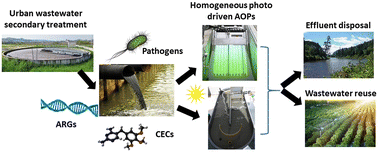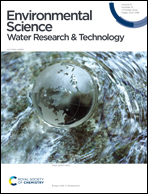Addressing main challenges in the tertiary treatment of urban wastewater: are homogeneous photodriven AOPs the answer?
Abstract
Homogeneous photodriven advanced oxidation processes (HP-AOPs) have been increasingly investigated in past years as a possible alternative solution to conventional tertiary treatment methods of urban wastewater. Despite the encouraging results in successfully addressing some of the main challenges, such as pathogen inactivation, removal of contaminants of emerging concerns (CECs), and antibiotic resistance (AR) control, their full-scale application is still poor. In this review, the main challenges in the tertiary treatment of urban wastewater are identified and the advances of HP-AOPs in addressing such challenges are critically discussed, emphasizing the respective advantages and drawbacks, even compared to consolidated tertiary treatment methods. Differences between solar- and UV-driven HP-AOPs, acidic vs. neutral pH photo-Fenton, as well as between homogeneous and heterogeneous photodriven AOPs are also analyzed and critically discussed. An approach for selecting model pollutants (e.g., CECs, pathogens, and AR indicators) as well as to validate under realistic conditions the results achieved under controlled laboratory conditions is also recommended. The most relevant issues and gaps in the knowledge are identified and discussed. A large number of investigations available in the scientific literature strongly support the capacity of HP-AOPs to effectively address the challenges in the tertiary treatment of urban wastewater, and the time for their full-scale application is almost mature. While the UV/H2O2 process is already applied as a final step in potable water reuse treatment trains, solar photo-Fenton has been quite exhaustively and successfully investigated in the tertiary treatment of urban wastewater so far and it is expected to be implemented at full scale in raceway pond reactors. In conclusion, 10 recommendations to take into account when designing the experimental plan are provided. Hopefully, this manuscript is also useful to water professionals and managers to learn possible effective and sustainable alternatives to conventional processes.

- This article is part of the themed collections: Environmental Science: Water Research & Technology Recent Review Articles and Recent Open Access Articles


 Please wait while we load your content...
Please wait while we load your content...